UNDER THE GREEN STAR
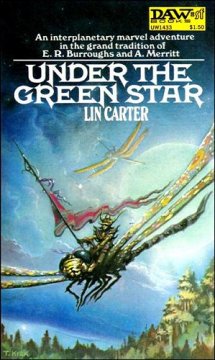 It's been about
five years since I last re-read the "Green Star" series and then one day
last week, it hit me. I HAD to read this incredible series again and so
I began with volume 1 (of 5) "Under the Green Star."
It's been about
five years since I last re-read the "Green Star" series and then one day
last week, it hit me. I HAD to read this incredible series again and so
I began with volume 1 (of 5) "Under the Green Star."
But before I get to the story proper, I'd like to mention the five plus
page Epilogue titled "Author's Note on the Burroughs Tradition" by Lin
Carter. Though situated at the end of the book, I read this first. How
ERB first wrote and sold "Under the Moons of Mars" to "All-Story Magazine"
in 1911 begins the essay and it expands to how Carter discovered Barsoom
as a lad down in St. Petersburg, FL. Further on he discusses other works
and authors of the Interplanetary Adventure (or Romance) genre and his
own role as an author. The difference between influence and imitation is
weighed with kudos to Norman's Gor books (first five only, I hope), Farmer's
"The Wind Whales of Ishmael" (one of my all-time favorites) and Leiber's
"Tarzan and the Valley of Gold." Carter hopes that "Under the Green Star"
will be as accepted as ERB influenced and not an imitation.
I believe that he did in fact accomplish this. Carter admits that his
upcoming Callisto books were written in the Burroughs style but not "Under
the Green Star," claiming instead to have utilized "a crisp, vivid style
A la A. Merritt prose." To my untutored eye, I see nothing of Merritt but
plenty of Lin Carter who combines adventure with a suitable dose of humor,
akin to his Zanthodon
books (which appeared later in the seventies and early eighties.)
If I were to find a Carter/Burroughs connection, aside from writing
Interplanetary Adventure tales, it would be that the World of the Green
Star (WotGS) has many geographic and plot similarities with ERB's Amtor.
In both, the hero (unnamed on the WotGS and Carson Napier on Amtor or Venus)
from Earth lands on the portion of the cloud-shrouded planet rearing city-bearing
forests with a civilization or city (the Laonese of Phaolon on tWotGS)
and the Vepajans of Kooaad on Amtor) in dire need of succor. And naturally,
there is a princess (Duare/Niamph) to be saved and her heart and hand won.
Further, both Carson Napier and Lord Chong (Chongaphon tai-Vena-Vena)
soon fall from a tree and are saved by the web of a giant spider (xoph
on the World of the Green Star and targo on Amtor). It is later learned
that these gigantic forests cover only a small portion of the planet and
the action does extend to oceans and far-off lands. The geography of both
planets seem compatible. So much so that I bet Den
Valdron could write an essay claming that both worlds are in fact,
one and the same. Naturally the difference in solar systems would have
to be explained...
But now, on to the story itself. By now, it is probably noted that neither
our adventurer from Earth or the planet he visits, are named. Only the
astrally/spiritually inhabited body of the in-stasis hero (Lord Chong)
is named and Carter keeps referring to the planet as the World of the Green
Star. Strange that not one civilization would have a name for their world.
Reminds me of Andre Norton's
Witch World in this regard.
The adventurer is a polio stricken man from Connecticut (near New Haven),
who manages to find the secret of astrally projecting his spirit to Mars
and later, the World of the Green Star, which beckoned to him like Barsoom
did to John Carter and Antares did to Dray
Prescot.
Some of what our hero experienced during his search and before leaving
our solar system is worth mentioning. Carter speaks of an ancient Earth,
before the rise of cities like Ur, of kingdoms such as Egypt and even civilizations
like Atlantis. It is the Uighur Empire of Asia he refers to and the book
"Kan Chan Ga" is a remnant of that empire, as are some of the remote Tibetan
lamaseries, one of which the book was "loaned" from. It appears that Carter
was a political conservative as he writes decisively about the Red Chinese
conquest of Tibet and later (in the Callisto
books), the communist actions in Cambodia. Not surprising, he was in
Korea when the red hordes poured south...
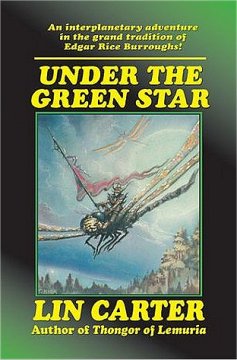 Visually, the
cover for "Under the Green Star" is stunning. DAW:SF Books No. 30 is illustrated,
both internally and the cover, by Tim Kirk. I got to know his superb work
very well with the Dray Prescot Saga. This book was published in 1972 with
no month given though the other four books do. The dedication was not to
ERB as might have been expected, considering Carter's Epilogue, but to
"Tom Anderson, who loves an old-fashioned yarn."
Visually, the
cover for "Under the Green Star" is stunning. DAW:SF Books No. 30 is illustrated,
both internally and the cover, by Tim Kirk. I got to know his superb work
very well with the Dray Prescot Saga. This book was published in 1972 with
no month given though the other four books do. The dedication was not to
ERB as might have been expected, considering Carter's Epilogue, but to
"Tom Anderson, who loves an old-fashioned yarn."
Back to Tim Kirk and his extraordinary cover art. It depicts the scene
from page 20 as a warrior of Arhda, astride his dragonfly (zaiph), zooms
toward Phaolon the Jewel City as part of his lord's (Tyrant Prince Akhmim)
retinue. Their purpose, to force Princess Niamh the Fair to marry Lord
Akhmim, the Tyrant Prince. This man is illustrated aptly on page 23, as
he makes his demands for marriage on Niamh the Fair (not shown). But the
great hall and myriad of courtesans are shown. A very nice interior by
Tim Kirk! Back to the cover. There is another warrior in the background,
as is the contour of a sun or moon. Clouds lurk on the fringes and the
tree line dominates the lower portion of the cover. Now I know that really,
most of what I described is technically wrong, though the warrior and steed
are virtually perfect and I might add absolutely stunning! But really,
there should be no star or moon, clouds or tree line visible because Phaolon
and Arhda are cities that occupy the middle terraces of the great forests
and so, a troop of warriors traveling between the two cities would be surrounded
by tree boles, branches and leaves. And yet, the liberties Tim Kirk has
taken have proved remarkably effective. He has caught the essence of the
World of the Green Star and how I wish I too could one day roam across
that world's surface in such fashion! Sadly, such steeds are not used beyond
the huge forests. More on what flying modes are available, later.
Our unknown hero speeds his way out of greater New Haven, CT, bypasses
the Moon with nary a glance and is astrally projected to Mars. Here, he
dwells a bit on Edgar Rice Burroughs and John Carter of Barsoom.
Though he wanted to "stride the dead sea bottoms of mysterious and romantic
Barsoom," what he found was different but no less extraordinary. A dead
city that once was a seaport, over a billion years ago. Much of the architecture
suggests slimness that could be extended to its former inhabitants. Just
a glimpse of Mars is given yet it is one I wish could be explored, even
if only in a short-story.
But it is from this lost city of Mars that the Green Star itself is
first glimpsed and focused on. In part because such colored stars are rare
but other reasons are hinted at and will be revealed later in the series.
Bursting through the cloud cover (not nearly as exciting as Carson Napier's
parachuting through Amtor's clouds), he witnesses the retinue of warriors
from Arhda winging it to Phaolon. Curious, he follows and soon arrives
in Phaolon the Jewel City and somehow gravitates toward the in stasis body
of Lord Chong. It seems, according to local legend, that the thirtieth
and last of his epical Thirty Deeds, involved slaying the evil wizard Kryaphaom,
the Lord of Ghosts. But in the process, Chong's spirit was sundered from
his flesh and hurled forth into the void of mists beyond the World of the
Green Star (to paraphrase). Now this brings to mind about just what the
heck has happened. Could our Earthman be an actual reincarnation of Lord
Chong? Was it his body, asleep on the WotGS that summoned him? It is true
that he learms the language and weaponry rather quickly, almost as though
he were remembering and not learning. But could latent memories in the
brain of the not-actually-dead Lord Chong be responsible for this?
Like Carson Napier, our Earthman who I will now refer to as Lord Chong
is taught the language, customs and political realities of the city he
has pledged himself two. And naturally, like Carson, he captures glimpses
of that city's Princess and is beguiled by her beauty. It is the savant
Khon-nom who undertakes the education of Chong. He is shown on page 35,
amid his scrolls as Chong pays close attention. Speaking of Chong, he is
shown from his backside on page 51 as he bones up on his archery. The combination
of a column-supported room and the vast forest beyond is a compelling one.
One of my favorite scenes in this book, indeed, in the entire series,
is the Dance of the Zaiph (pages 52 & 53). Chong, Niamh and members
of the Laonese nobility fly out on their giant moths or dhuas and watch
as several male zaiphs strive to mate with the just released queen. Only
the mightiest can attain her and eventually he does, their copulation witnessed
by all, as the two zaiphs drop from sight in post-coital bliss. As they
plunge below and through the branches, Lord Chong and Princess Niamh, caught
up in the ecstasy of what they had just witnessed, look into each others
eyes and it is done. Chong knows he is in love and Niamh knows he is too.
But does the Princess love Chong? We'll take a look at this later on.
A picnic takes place soon after the Dance of the Zaiphs and as illustrated
by Kirk on page ii, a dragon-like beast, the ythid attacks and naturally
goes for Niamh. I guess princesses stick out more than common nobles or
warriors. Lord Chong is the first to spring to her defense but he soon
finds himself on the losing end. No disgrace here as the ythid is the most
feared, almost legendary, beast of the forest. Thankfully, the archer Panthon
comes along to slay the dragon but in all the chaos surrounding the dying
ythid, both Chong and Niamh are catapulted into the Abyss. As I mentioned
in my first post, both are saved from death by landing in the huge web
of the spider-like xoth. So too did Carson Napier but not with his Princess,
Duare.
For the rest of the book, Chong is at Niamh's side and strives to defend
her from foes, human, animal and even from vampire blossoms. In fact, Chong
was about to (again) fall prey to one of the WotGS's predators, this vampire
blossom when he and Niamh are saved by Siona the bandit queen and her band
on patrol (as illustrated on page 86 via a rather busy Robin-Hoodish manner).It
is as guests (sort of) of the outlaw village (called the Secret City) that
the final half of the book takes place. I should have noted that Lin Carter
divided the 138 page book into four Parts with five Chapters per Part.
Each Part is named for a main character who dominates the action within:
Chong, Niamh, Siona and Sligon.
The protagonist makes some comments on page 78 that I would like to
share. This paragraph probably explains why I like reading so much of Lin
Carter. Here we go: "For here I was a man, a splendid savage, not a hopeless
cripple. Never before had I truly lived, tasting life with an appetite
spiced with danger, feeling pride in my own prowess, knowing that each
day I would face new and more horrendous perils, but knowing, at least,
that I lived each moment to the hilt, with verve and gusto, with excitement
and suspense, with romance and mystery and adventure, by the side of the
most beautiful woman of two worlds!" Whew! Most of that in one sentence
but an effective (however long) sentence at that!
The questions of size and time on the WotGS are raised by Lord Chong,
thinking as an Earthman. Page 81 contains his thoughts on the former and
basically he wonders if the towering trees are truly huge or if the human
inhabitants of the forest are miniscule. After all, the dhuas (moths) and
zaiphs (dragonflies) are larger than men and even a snail (slain for a
meal by Lord Chong) is dog-sized. Lastly, he wonders if his astral projection
had lost all sense of proportion but decides he may never know the answer.
I do know that once our protagonist (who will NOT be Lord Chong), leaves
the forest behind on his adventures, proportion does not seem to be an
issue.
As for time, Chong ponders the topic on pages 101-103. He notes that
it goes largely unmarked by the Laonese and no divisions of time are used
at all. The possibility that the Laonese are of a pre-industrial civilization
and can't make clocks or watches is raised. Secondly, Chong states (bottom
of page 101) that the Laonese rarely observe their sun and stars of nearby
constellations, with a comparison to Venus offered up. No seasons are referred
to but perhaps because there are no seasons, due to a "not so severely
inclined axis." Birthdays or ages seemed to be known of but not discussed.
Lastly, the non-observance of time could possibly translate into perpetual
youth. But Chong leaves such thoughts for philosophers. After all, he is
a man of action!
While "guests" in the Secret City of Siona's outlaws, Chong makes an
enemy of Sligon (as seen on page 118), and ultimately causes Chong's death
by stab wound. As our hero slowly dies it is Siona who cradles his head
and weeps, not Niamh. For she is fleeing the outlaw village, thanks to
Chong's fighting to make escape by zaiph and at night, possible. The Ardhese
have sent ambassadors to the outlaw village in seeking an alliance. They
wish to use Siona's band as scouts in their upcoming war on Phaolon. Sligon
(who had overheard and knew who both the princess and her protector were)
dies before Chong, but die our protagonist does and his spirit goes dark
before he awakens in Connecticut, almost dead. Even in stasis, his body
needed nourishment of some sort and this will be further noted in the last
book of the Green Star series. But for being rescued by Panthon (the archer
who I'd like to see more of) the xoth web and Siona, Lord Chond dies four
times. Makes you wonder how he survived the first 29 of his 30 Epic Deeds?
But, Chong is dead, never to come back. Lin Carter killed off the hero!
I remember reading "Under the Green Star," the year I graduated high school
and thinking to myself, "Well, that's a hell of an ending. Chong is dead.
Now what?" Little did I then know but Carter had a plan and a magnificent
one it was. More on this when I review "When the Green Star Calls."
One of the blurbs on the back cover, in that famous DAW font that adorns
the back covers of tales of this kind, says it all:"For there was a princess
to be saved, an invader to be thwarted, and other-world monsters to be
faced..." Way to go Lin!
In closing I thought I'd mention the only geographical references thus
far in the Green Star series:
-
Phaolon the Jewel City - Home of the Laonese.
-
Arhda - Nearby rival city, ruled by Akhmim, the Tyrant-Prince.
-
Kamadhong - A distant tree city mentioned by Niamh to Siona.
-
Secret City - The outlaw village. Lower in the forest terraces than Phaolon
and Ardha.
-
World Above - A legendary place of spirits and demons.
-
Abyss - A legendary place of horror on the planet's surface within the
forest.
Because Lin never made a map, I did. It is crude but shows most of the
major areas of the action within this five book series. (Editor's Note:
The map will appear here, shortly)
When the Green
Star Calls
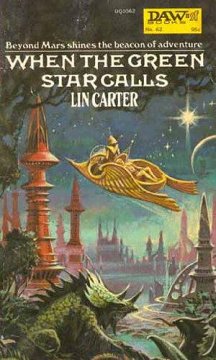 As
the title implies, I was in fact drawn back to the World of the Green Star,
not long after finishing "Under the Green Star." Truth to tell, I've always
been more interested in the adventures of Karn the Hunter, late of
the Red Dragon Tribe, than those of Lord Chong. Possibly because, back
in 1973 when first I read "When the Green Star Calls," I was nineteen years
old and could relate better to the 16 to 17-year-old Karn.
As
the title implies, I was in fact drawn back to the World of the Green Star,
not long after finishing "Under the Green Star." Truth to tell, I've always
been more interested in the adventures of Karn the Hunter, late of
the Red Dragon Tribe, than those of Lord Chong. Possibly because, back
in 1973 when first I read "When the Green Star Calls," I was nineteen years
old and could relate better to the 16 to 17-year-old Karn.
The top of the back cover shouts out at me: "Unknown world for conquest!"
I remember thinking this blurb must refer to the designs of the Laonese
city Ardha, lead by its Great Prince Akhmim, against the jeweled city of
Phaolon. And it may as the plans for the invasion go on, but local politics
and a lack of funding, prevent the actual onslaught which most involved
believe will be a one-sided affair, with Ardha the sure victor. This it
seems, due to the more war-like nature of Ardha as opposed to the elfin-like
nature of the Phaolonese, though both peoples are of the Laonese race.
But in fact, this blurb probably refers to the efforts of the mad-scientist,
Sarchimus, to become immortal (or at least be able to live forever if not
killed violently), and utilize an army of robots to slaughter the armies
of the Laonese and rule the forested portion of the world. For who knows
what lay beyond, above or below? Hardly a thing at this point but there
are legends...
The cover art by Luis Dominguez is a thing of real beauty. Here we see
Sarchimus taking Karn back to his Scarlet Pylon within the Dead City of
Sotaspra, as revealed on page 34. The sky sled, dead city, unknown reptile,
tree fringe, sky and moon (yes, a moon!) are combined in a most colorful
and detailed manner. For sure, as the blurb above the title says, "Beyond
Mars shines the beacon of adventure."
The tale begins with our crippled (polio) Earthman hero deciding (as
we knew he would), to return to the World of the Green Star. After all,
he was "called." Back in the first book, he traveled first to Mars but
had noted the Moon. Noted, but did not visit, and I recall wishing he had.
Not to worry as this book fulfilled my yearning. A pillar of iron is discovered
and determined to be the work of man, complete with Sanskrit-style writing.
A possible tie-in with Mars is postulated as well as Mu and Atlantis.
A flashback happens as our hero prepares to leave the Moon for his final
destination. It relates information gleaned from the Gupcha Lama and much
of it is very much Clark Astin Smith-like in nature. Pages 22 & 23
are devoted to alien beings from across the galaxy and how some interacted
in Earth's dim past and future. There is even a nod to Antares where an
immortal wizard dwells on a dead world. Surely this image must one day
confront the Kregoinye Dray Prescot as he does the bidding of the Star
Lords!
As the disembodied spirit finally turns away from both the iron pillar
and his thoughts, he thrusts up and away from the Moon "and in that sky--the
Green Star blazed!" Indeed it did and to it he goes, called to it...
A great start and we haven't even reached the Green Star!
The plot involves our hero entering the body of Karn upon the precise
moment of his death from a giant scorpion (phuol) sting. Carter describes
this in great detail on page 37, as the boy's vital energy and ultimately
his soul, leave the body. Lin does not voice an opinion on where the soul
goes or what the significance of having one is. I wished he had though
I believe he was an atheist. Well, he does go into it a little bit, two
pages later. He states that Chongs spirit had been "torn from his flesh
and driven forth to wander forever among the stars." As for Karn's spirit,
Carter does not speculate.
Karn is held captive (with lots of free reign), by Sarchimus who needs
the forest hunter as a test subject in his quest for the Kaloodha elixir
of immortality. In the process of snooping about the pylon, Karn discovers
Zarqa, last of the winged Kaloodha and Janchan, a prince of Phaolon. All
three escape and Sarchimus dies in a horrible but appropriate fashion.
They seek out Ardha to see if Niamh might be there and sure enough, she
is!
All three adventurers become separated once Ardha is reached. Niamh
is rescued by Janchon and Zarqa, with the voluptuous Arjala (High-Priestess)
in tow. Karn and the loveable rogue Klygon, witness the rescue as the sky
sled speeds away. The story ends with the shocked Karn expecting death
from Klygon the Assassin, for failure! A veritable cliff-hanger indeed!
As much as I loved action and atmosphere of this book, I do have have
a few plot issues I'd like to raise.
1. Why did Sarchimus experiment on Karn instead of Janchan,
like he had with the other members of the Phaolonese search party?
2. Why didn't Zarqa allow Karn and Janchan to imbibe of the immortality
serum? Sooner or later these two and other friends to come, will die, leaving
the Zarqa to go on, possibly forevere without his first true human friends.
3. The Secret City of the Outlaws is described (page 100) in this book
as being situated over five miles above the ground, higher than the cities
of the Laonese. But I seem to recall Chong and Niamh going (falling) toward
the ground when they were then rescued by Siona.
4. Why hadn't Prince Janchon seen Lord Chong at all during this days
in Phaolon? Surely he had to have been present when Akhmim had presented
his ultimatum for the marriage to Niamh and the merging of the two realms.
5. What is a prince? I thought princes were the sons of kings or emperors.
But Janchon is neither, sometimes referred to as a princeling. Perhaps
it refers to a related member of the royal family, distinguished from run
of the mill nobility.
I have mentioned my home-made map of the known portions of the World of
the Green Star but Karn actually gets to peruse one (pages 73 & 95),
courtesy of Hoom of the Many Eyes. It would appear to only show the forested
or the local forested areas of this world.
The interior illustrations by Dominguez are pretty darn good and attention
to textual detail is observed. The Frontispiece shows Niamh with Janchon's
sword as they prepare to flee (see page 143). A muscled eunuch and Arjala
look on and react to the danger winging towards the. The result is freedom
for two, death for one and captivity for the last.
Page 32 depicts Sarchimus first coming upon Karn but too late to prevent
the sting of the phuol, which seems to resemble the reptile to the fore
of the front cover. A nice view of how the tree branch fits into
such a scene.
Zarqa is revealed on page 63 as Karn discovers his prison. A little
too much darkness for my taste but always a possibility with interior illustrations.
Sarchimus standing over the stricken Karn is depicted on page 79 in
the penultimate drawing. A nicely detailed view of both characters and
room they are in.
Lastly, another darkish page (97) as Zarqa pilots the sky sled from
the doomed Scarlet Pylon, with Karn and Janchan as passengers.
Back in 1973, I had no idea what lay ahead for Karn and his companions
or how long the series would last. Now I do but that knowledge doesn't
appreciably lower my heightened expectations for the last three books.
Au contraire, knowing, I relish!
By The Light
of the Green Star
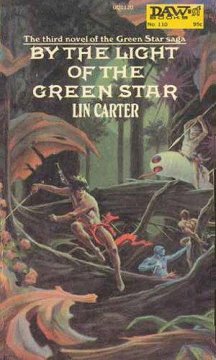 "By
the Light of the Green Star" is the "third marvel adventure of Lin Carter's
best-selling saga." That's what the blurb on the back cover. It also states
"Miscast in the role of assassin, inhabiting the stolen body of a stalwart
savage, the star-wanderer from Earth found himself in dangers beyond even
his wildest imaginings. His friends had fled, his princess with them, and
awaiting him were the islands of the sky with their merciless masters,
the prowlers of the dark tree bottoms with their terrible steeds, and the
treachery of his comrades in captivity."
"By
the Light of the Green Star" is the "third marvel adventure of Lin Carter's
best-selling saga." That's what the blurb on the back cover. It also states
"Miscast in the role of assassin, inhabiting the stolen body of a stalwart
savage, the star-wanderer from Earth found himself in dangers beyond even
his wildest imaginings. His friends had fled, his princess with them, and
awaiting him were the islands of the sky with their merciless masters,
the prowlers of the dark tree bottoms with their terrible steeds, and the
treachery of his comrades in captivity."
Really, these blurbs say it all, plot-wise. The 168 pages are divided
into five "books" and twenty chapters, similar to what Lin uses in his
Callisto, Zanthodon and World's End series. There is, however, a slight
variant when compared with the first two Green Star books. "Under the Green
Star" had four "books" (with twenty chapters/138 pages) while 'When the
Green Star Calls" had five "parts" instead of books (with twenty-five chapters/176
pages). Still, whether as parts or books, the bunching of chapters in the
first two books were named after the lead character there-in. "By the Light
of the Green Star" reverts back to "books" but are named after the major
pieces of action contained within. This too does Carter with his other
series from the seventies and early eighties.
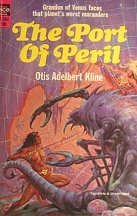 Illustration
honors, in publication order, go from Tim Kirk, to Luis Dominguez and now
to Roy Krenkel. The latter's cover of "By the Light" is very reminiscent
of his Ace work on Otis Adelbert Kline's "Port of Peril." If I had to rank
these three covers, I'd definitely go with Kirk's cover of the first book.
The dragonfly steed (zaiph), warrior and forest are superbly drawn. Second,
Dominquez has captured perfectly the essence of Karn being transported
by Sarchimus into the Dead City of Sotaspra. Though last, of the first
three Green Star covers, how can I not appreciate Krenkel's depiction of
Karn, Klygon, Delgan of the Isles and the albino/cannibalistic surface
dweller astride his monstrous worm (sluth)?
Illustration
honors, in publication order, go from Tim Kirk, to Luis Dominguez and now
to Roy Krenkel. The latter's cover of "By the Light" is very reminiscent
of his Ace work on Otis Adelbert Kline's "Port of Peril." If I had to rank
these three covers, I'd definitely go with Kirk's cover of the first book.
The dragonfly steed (zaiph), warrior and forest are superbly drawn. Second,
Dominquez has captured perfectly the essence of Karn being transported
by Sarchimus into the Dead City of Sotaspra. Though last, of the first
three Green Star covers, how can I not appreciate Krenkel's depiction of
Karn, Klygon, Delgan of the Isles and the albino/cannibalistic surface
dweller astride his monstrous worm (sluth)?
There is a paragraph on page 18 that pretty well sums up the actions
by Karn of the Red Dragon in the last four books of the series. It reads:
"And while I and Niamh the Fair yet live, and share the same world between
us, I shall not give up hope. For somehow, though a thousand perils stand
between us, I can yet aspire to battle my way to a place by her side, and
to win again the heart that once I won, when I was Kyr Chong the Mighty."
Typical Lin Carter? You bet, but then I wouldn't have it any other way!
I don't recall if I have addressed the absence of moons orbiting the
planet but this is addressed on pages 24 & 45. On the former, Karn
states "The nights on the moonless World of the Green Star are black and
lightless" while the latter page reveals Karn's thoughts: "If the planet
had any moon at all, which was doubtful, it was above the clouds that enveloped
the planet and its rays were too dim to penetrate the cloudy veil." Hmm...
A little leeway perhaps?
I believe Den had mentioned (among several things), that Carter's time-line
of the World of the Green Star, should not be taken literally or seriously.
I agree. At various times throughout the book he throws out terms like
"since Time's forgotten dawn, and a million years of evolution." This in
reference to the Laonese dwelling among the mighty trees and having an
incredible sense of balance. A few pages later, Carter speaks of "A million
generation of tree-dwellers." Again, concerning the Laonese (and Karn's)
lack of vertigo. There is a huge difference between a million years and
a million generations. About nineteen million years.
The Kalood, of which the winged Zarqa was the last surviving member,
"ruled all this world in the days before mankind arose from the murk of
brutehood." Seems that humans (or some humans) evolved on this planet and
were not colonists from Barsoom, Amtor or elsewhere. That is, if Carter
(speaking through the Janchan, a prince of Phaolon), can be believed.
Zarqa has lived for a million years, or at least that many since his
last Kalood brethren died. But the Kalood race goes back "a billion years,"
according to the brooding Zarqa as he contemplated the Flying City of Calidor.
One last time-line, the noble Clyon tells the scientist Ralidux that
'Over nine millennia have passed since the immortal Lysippus, with the
concurrence of the Council of Science, established the doctrine of the
bestiality of the (human) creatures, and their innate inferiority."
Speaking of this doctrine, I have a difficult time believing that the
Skymen of Calidor haven't caught onto the speech of the humans from the
tree cities. Karn understands the Skymen, albeit with some effort, but
he does comprehend the gist of what they say. And the Skymen have not once
spotted a Laonese city despite capturing many of their inhabitants? Just
the fact that both peoples are formed almost exactly alike should provide
the Skymen with a clue to the intelligence of their captives. We're talking
apples and apples here, not apples and oranges like comparing man to chimp.
The title is used on page 26 as Karn "By the light of the Green Star
saw the incredible vistas fall away to every side..."
Geographically, Phaolon is the nearest city to Ardha and the Laonese
do have a word for sea, "zand." Yet, Karn and Klygon and later, Niamph
and Arjala, are stunned when they actually see or float into it. The thoughts
of the lust-driven Ralidux concerning the sea are not revealed...
Though several species grow to great size on the World of the Green
Star, for instance:
-
Moths (Dhua)
-
Ants (Kraan)
-
Scorpions (Phuol)
-
Worms (Sluth)
-
Spiders (Xophs)
-
Dragonflies (Zaiphs)
-
Bees (Zzumalak)
I have a hard time believing the described size of the Zawkaw or hawks.
'But the zawkaw is a bird -- a bird more enormous than any whale that ever
swam in Earthly seas... Here on the World of the green Star the ferocious
hunting hawks "grow as huge as dinosaurs." Until I re-read these passages,
I had envisioned beasts like the tarns of Gor. In fact, I prefer that vision.
Krenkel adds five interior illustrations ranging from "too busy" to
"fantastic." Ralidux in his garden and the first view of Calidor, the Flying
City are examples of the latter.
Lin includes five pages of glossary for the beasts and people of this
world. A nice touch, that as is seeing the order form at the very end for
other Green Star books plus most of the Delian Cycle of Dray Prescot.
By book's end, the two parties of adventurers have escaped the perils
of the World Above and the Abyss, leaving many other captives to the tender
mercies of the inhabitants there. But the sea and the lands on and beyond
it will be the scene where most of the action of the final two books in
the series takes place. I'm ready for the change but do look forward to
a return to the tree cities of the Laonese, eventually.
AS THE GREEN STAR RISES
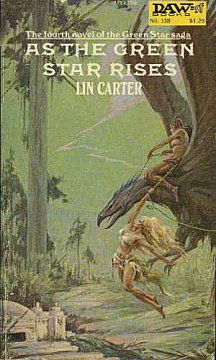 This
is another great planetary adventure book by Carter that honestly, captivates
me every time I read it. Though reminded of Carson Napier's adventures
on Amtor, the Green Star books read like Carter and not Burroughs or any
other author. N'est pas?
This
is another great planetary adventure book by Carter that honestly, captivates
me every time I read it. Though reminded of Carson Napier's adventures
on Amtor, the Green Star books read like Carter and not Burroughs or any
other author. N'est pas?
My latest re-read of Lin Carter's "As the Green Star Rises" was pure
joy as I was either on my daughter's fiance's dad's sail boat or on a beach
at Martha's Vineyard.
Naturally, the cover art by Roy Krenkel jumps right out at you. It depicts
the action at the bottom of page 60 where the "Goddess" Arjala is in panic-stricken
flight from Ralidux. She is astride his giant (Zawkaw) hawk and instinctively
grabs the reins and lifts off as Niamph the Fair rushes toward her, just
ahead of the monstrous Ssalith (200' snake) and Ralidix (the latter two
not shown on the cover). Niamph lunges for the reins in desperation and
just manages to grasp the dangling stirrups, as the hawk rises from the
clearing with the temple of the Ancient Ones (more on them later), on a
nameless jungle isle on the Sea of Komar, in the background. Krenkel does
his usually superb job with the two princesses, the abandoned temple and
the surrounding jungle. Of course, the color green dominates, as Krenkel
must surely have been told to do. Just a great cover and so, a fantastic
way to begin the book!
Turning the book over, the back cover blurb proudly exclaims: "Daybreak
of Adventure: In the marvel-adventure sagas of Edgar Rice Burroughs, Otis
Adelbert Kline and John Norman, has there ever been a situation such as
befell the Earthling who found his way to the world under the Green Star?...His
courage never flagged though the greatest of risks would confront him AS
THE GREEN STAR RISES."
I would have liked to see Ken Bulmer (Alan Burt Akers) mentioned as
his Dray Prescot Saga was a major DAW fixture in 1975. In fact, the first
seven books are advertised in the rear of this book, as well as the three
earlier Green Star and latest "Hunters) Gor book.
Carter once again divides this 172 page novel into five Parts, each
titled as The Book of (fill in major characters name). These Books are
subdivided into five Chapters, each marvelously named. Lin begins with
his Editor's note, disclaiming authorship of the Green Star books and admitting
to only dividing the action into the five Books/25 Chapters and afixing
the title.
Karn the Hunter of the Red Dragon people is still blind as this book
begins, from blasting the Nithogg (giant white worm), during his escape
from the troglodytes in the Abyss. Sword companion Klygon and soon to be
traitor Delgan of the Isles, escape with Karn to the Sea of Komar via the
river that flows through the Abyss. Events soon separate the three while
the adventures of Niamph, Zarqa, Janchon and Arjala are chronicled separately
but along the same timeline.
I had mentioned the Ancient Ones earlier and they piqued my curiosity
though Carter gives out enough info to tantalize. On page 51 he states:
"Niamph, too, was an Initiate of the Mysteries. She knew something of the
lore of that vanished race, rumored to have existed on the extremeties
of the planet during its youth. They had been contemporaries of the Winged
Ones, of the Kaloodha, of Zarqua's long-extinct people, had the mysterious
Ancient Ones. Alone among the many denizens of the World of the Green Star,
they had built their habitations upon the surface of the planet, rather
than aloft amidst the branches of the gigantic trees."
This makes we wonder just how much of this planet is covered by the
stupendous forest that houses the cities of the Laonese. Could it be a
relatively small area like on the island of Vepaja in ERB's Amptor series?
Let's face it, Carter had only begun to explore the World of the Green
Star. I sometimes fantasize that the Carter heirs would appoint a writer
of renown to write more books set in the worlds of Lin Cater, with those
of the Green Star predominating.
Then on page 69 it is revealed that "He (Ralidux), entered a huge stone
vault filled with the incomprehensible mechanisms used by the Ancient Ones."
Among these was an airship similar to that of the Kaloodha. That's about
it. Maybe Den can figure out the relationship between these two extinct
races of the Green Star. There was more data on the Kaloohda in the first
book of this series, "Under the Green Star."
The subject of size is taken up again by Karn as he and Shann (really
Niamph), breakfast on normal size pear, banana and berry-shaped fruits,
while trying to survive on their nameless isle amidst the Sea of Komar.
Many fruits in the forest were as huge as the insects that abounded there.
Oh, a funny scene while the still-blind Karn and Shann (Niamph) are
on this isle. Karn had just washed his ragged garments and had stretched
out naked to enjoy the sun. Niamph returns from gathering fruit and gasps
in shock, dropping her fruits with a thud, but uttering no comment oh Karn's
exposed manhood. If he ever knew it was Niamph and not Shann of Kamadhong...
Speaking of Karn's blindness, his sight finally returns on page 163,
to my (and surely, Karn's) great relief. His first view was that of the
Green Star, rising!" It was the Wizard Prince Parimus of Tharkoon who accomplished
this restoration, with his knowledge of the Ancient Ones.
The adventures are fast and furious and by book's end, Karn, Klygon,
Zarqa, Janchan, Andar (Prince of Komar), Eryon (warrior of Komar and comrade
to Klygon) and Arjala (whom Prince Janchan was very much in love with),
are all gathered in the city of Tharkoon, the Blue Barbarians having been
thrown out of the island nation of Komar by our heroes and friends.
But in the Epilogue, a stunning event takes place. The Ancient One's
airship (the 'Xothun"), glides in toward Tharkoon with Ralidux and Niamph
aboard. The princess knifes her foe in the heart killing him but Delgan
of the Isles, the Warlord of the Blue Barbarians, takes the opportunity
to jump aboard from a colossal idol. So too does Zorak the Bowman and the
struggle for supremacy of the "Xothun" ensues, with the airship veering
toward the gigantic forest. Personally, I'm surprised that the edge of
the forest (what a sight it must be!), could be seen from the Sea of Komar.
Just before the Ancient One's airship enters the forest, a body plummets
from the airship, but whose? Looks like I'll have to wait for the fifth
and last installment in the Saga of the Green Star to find out. I relish
the opportunity to do so!
IN THE GREEN STAR'S GLOW
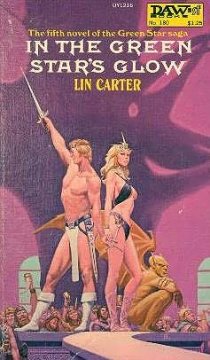 "In
the Green Star's Glow" reverts to the chapter naming device of plot as
opposed to character. The exception being that there are five chapters
per book in "Glow" as opposed to four in "Light." Curiously, only five
pages more appear in the climax to Lin Carter's World of the Green Star
Saga than in the third installment. Another (and probably useless) piece
of chapter info, both books are divided into "Books," as usual, but not
by "Parts" as the other three novels do. In Carter's "Editor's Note" on
page 183, he states "Unless the post office has goofed again, you should
find enclosed herewith a bundle of manuscript which I have entitled In
the Green Star's Spell." Hmmm... I think it a better title than that
used.
"In
the Green Star's Glow" reverts to the chapter naming device of plot as
opposed to character. The exception being that there are five chapters
per book in "Glow" as opposed to four in "Light." Curiously, only five
pages more appear in the climax to Lin Carter's World of the Green Star
Saga than in the third installment. Another (and probably useless) piece
of chapter info, both books are divided into "Books," as usual, but not
by "Parts" as the other three novels do. In Carter's "Editor's Note" on
page 183, he states "Unless the post office has goofed again, you should
find enclosed herewith a bundle of manuscript which I have entitled In
the Green Star's Spell." Hmmm... I think it a better title than that
used.
Michael Whelan illustrates "Glow" joining Roy Krenkel ("Rises" with
Michael Kaluta & "Light"), Tim Kirk "Under") and Luis Dominguez "Calls").
Like his talented predecessors, Whelan does a phenomenal job. In particular,
his depiction of Niamp, while not accurate (she is much younger and less
developed), is superb! Karn and Zarqa (the only other characters I recognize
on the front cover), are as I envisioned.
Zorak the Bowman, figures in the frontispiece and another interior illustration
while Quoron the Mad Scientist, Niamh and the two-headed Number Nine constitute
my second favorite. The depiction of Delgan (formerly of the Blue Horde)
and Kraan King Rkhith, surrounded by several other insect-like Kraans as
they pour into the outskirts of Phaolon, remains my personal favorite.
I know I've brought up the subject of size in previous Green Star reviews,
but I feel compelled to do so one last time as it appears Carter has thrown
in something a bit more solid than here-to-fore. First, on page 40, large
dewdrops are discovered by Niamh where upon she drinks her fill. I mention
this because I don't recall dew as being among the things that appear gargantuan
in size during this five book saga. More importantly, Carter (via Karn/Earth
Hero) makes this declaration on pages 40 & 41: "I have never been able
to figure out the weird, disproportionate sizes on the World of the Green
Star. On that planet, either humans alone retain their terrestrial size,
while every other thing has grown tremendously larger, or all other forms
of life but human are of natural size, while men and woman are miniscule.
The immense size of dewdrops may indeed be a clue pointing to the
latter theory, for on Earth, the surface tension which holds a drop of
water together is too feeble to sustain a waterdrop to any particular size.
Therefore, unless the laws of nature are radically different on the World
of the Green Star, the evidence suggests that people are very small.
Personally, no matter how one looks at it, either theory runs radically
contrary to the laws of nature on Earth. Miniscule humans or large insects
(trees and drops of dew), both seem contrary to me but at least Lin provides
his thoughts on the subject. I wonder if he knew this when writing "Under
the Green Star" in 1972 or decided to address this issue in late 1975 when
"In the Green Star's Glow" was being written? Either way though, why are
the ratios "normal" surrounding the Sea of Komar?
I came across a piece of geographical data that would change my hand-crafted
map of the known areas of the World of the Green Star. On page 47, Karn
heads north from the archipelago nation of Komar via sky-sled, toward the
forest of giant trees. My map shows the forest being due east, but that
was because I had missed the "north" reference and it was easier going
with "east." This being said, I do not feel compelled to revamp my map
as, in general, it works.
Another geographic reference I left out was the (guessed at) location
of the camp of the Amazons. No big deal since those young man-haters (and
understandably so), have long since been relocated to Phaon where their
leader, Varda, has fallen in love with Zorak the Bowman. It is thought
that he will soon be unable to resist her wiles and they will be wed.
I should point out that my map contains places that are mentioned but
hardly ever located precisely, especially in the great forest. Where hints
have been given, I have utilized them to the best "guestimates" I could
offer. We know that Ardha, Phaolon, Barganath, the Dead City of Sotaspra,
the Secret City of the Outlaws and the camp of the Amazons must be fairly
approximate (as far as places can be in this forest), and I have shown
them thusly to be. Kamadhong is said to be distant, a convenient place
to be from if you want to claim to be a mercenary, a plot devise that Edgar
Rice Burroughs was fond of in his Barsoom and Amtor planetary adventure
series.
A few more comments on geography if I may. On page 56, Zorak comments
to Xikchaka the Kraan, "Never before have I heard that the mighty Kraan
of the restless hordes could converse with the tongue of men." Being a
warrior from Tharkoon upon the Sea of Komar, how could he have even known
of the existence of the insectoid Kraan?
The Blue Horde was originally from the forested area of the Green Star
World but somehow found its' way to the Sea of Komar. Should I be asking
how and if Delgan was responsible for this or should I be inquiring why
no other adventurers from the forest had ever made it to Komar of Tharkoon?
Or had they?
I had always assumed the term Laonese to refer to theose that dwelled
in the tree-top cities. I don't recall Lin using this term with those of
the Sea of Komar. Yet, on page 69, in both the body of the story and the
footnote, it is clear that the term refers to both areas of the planet.
For example: "The Laonese manufacture metals, but do not mine for them.
The only exception to this practice may be the Komarian isles and seacoast
cities." In the footnote: "The only Laonese cultures which do employ agriculture
are the denizens of the coastal cities about the Komarian sea, such as
Zorak's own kingdom" (of Tharkoon).
On page 121, Carter states that "That forest, of course, stretched in
an unbroken mass from horizon to horizon and from pole to pole, covering
, insofar as any of us then knew, the entire surface of the World of the
Green Star. The only portion of the planet's surface which was definitely
known to be free and unencumbered by the world-forest, was of course,that
portion occupied by the Komarian sea."
One last point on geography (I promise!), could Carter have actually
named the World of the Green Star? On page 137, Karn is discovered by Iona
when Varda jumps his bones in the camp of the Amazons. "All around her
(Iona), the world-forest was drenched in utter gloom. The moonless nights
of Lao are abysses of unbroken blackness, and the inhabitants of the forest
world are unaccustomed to venture abroad during the hours of darkness,
except on furtive missions of stealth and secrecy." so, the World
of the Green Star is called Lao. It makes sense but I suspect Lin slipped
up here an inadvertently dropped this bombshell (to me) by mistake.
Plot-wise, "In the Green Star's Glow" is the story of Karn's search
for Niamh and the prevention of the Blue Horde assault on Phaolon by the
Kraan at the instigation of Delgan, formerly of the Blue Horde, now decimated.
Naturally, Zarqa and Zorak feature prominently and all ends well in typical
Linwood Vrooman Carter fashion. Or as stated on the back cover: "But dare
he (Karn) must--for though that alien planet (of Lao) was replete with
dangers and treachery, with lost castles of forgotten science (like that
one of jade in which Niamh was held captive by Quoron), and armies of mindless
monsters (the Kraan), there was a cause to be won and a love to be rescued.
It's Lin Carter in the grand climax of his best marvel-adventure series
in the tradition of Burroughs and Merritt."
The adventurer from Earth returns one last time to his bed-ridden body
deposits the last four stories of his saga, the first already set aside
after he died as Chong the Mighty. He ends his tale with: "But there, on
the World of the Green Star, I am a warrior and a hero, a husband, a lover,
and a king. Never thereafter shall I wander the starry firmament again.
For, on that weird and terrible and beautiful and wonder-filled planet
of strange beasts and even stranger men, I found my heart's home. I am
caught in the Green Star's spell. Nor do I ever wish to be freed from that
sorcery." Now this is my kind of ending!
Carter follows "The Aftermath" (the unnumbered and not part of the Fifth
Book), with an "Editor's Note." Several names and places are mentioned
that might make for some interesting Internet searches. I'll leave that
to another soul, more intrepid than I am as concerns this. But I found
the following statement by Lin to truly capture the full flavor of this
saga: "That secret (the veracity of the truth in the five manuscripts),
has carried with him to his grave. Or...beyond! To a mist-veiled world
of mighty trees that is bathed in the emerald radiance of the Green Star...
Who knows? Certainly not I."
Tom Anderson is mentioned is mentioned as the liaison between Carter
and the actual author of the saga. A man of this name has "Under the Green
Star" dedicated to him since he loves old-fashioned yarns. Also, Lin mentions
his typist, Scott, who may or may not be Scott Bizar who also like old-fashioned
yarns, as stated in the dedication for "When the Green Star Calls."
Lastly, an Appendix of people graces the end of "In the Green Star's
Glow" and the saga is brought to a most satisfactory conclusion, except,
I want more! Only the smallest of portions of Lao have been explored thus
far. Who knows what wonders and threats lie beyond the horizon?
The world-forest is said to occupy all of Lao except the area surrounding
the Sea of Komar. But the forest is only mentioned as being north of that
sea. What id Karn/Lin are wrong and non-forested lands extend beyond Komar?
Even closer to home, what about the rivalry between Phaolon and
Ardha? The last I remember, Akhmim the Tyrant-Prince was still in control
of that city, especially with Arjala, Hight Priestess of Ardha, removed
from the scene.
And surely the threats from the Abyss (Gor-ya's cannibals) and
from the World Above (the Skymen of Calidor and other possible flying cities)
are still current and viable.
Well, so much for the Green Star Saga. It's been a typical Lin Carter
roller coaster ride and I wonder what I should read next by him?
Steve Servello






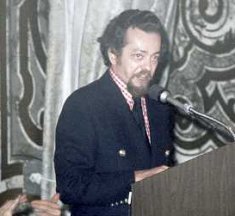
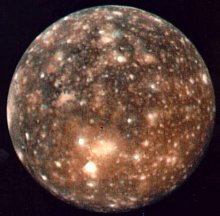
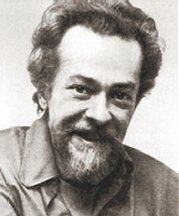
 It's been about
five years since I last re-read the "Green Star" series and then one day
last week, it hit me. I HAD to read this incredible series again and so
I began with volume 1 (of 5) "Under the Green Star."
It's been about
five years since I last re-read the "Green Star" series and then one day
last week, it hit me. I HAD to read this incredible series again and so
I began with volume 1 (of 5) "Under the Green Star."
 Visually, the
cover for "Under the Green Star" is stunning. DAW:SF Books No. 30 is illustrated,
both internally and the cover, by Tim Kirk. I got to know his superb work
very well with the Dray Prescot Saga. This book was published in 1972 with
no month given though the other four books do. The dedication was not to
ERB as might have been expected, considering Carter's Epilogue, but to
"Tom Anderson, who loves an old-fashioned yarn."
Visually, the
cover for "Under the Green Star" is stunning. DAW:SF Books No. 30 is illustrated,
both internally and the cover, by Tim Kirk. I got to know his superb work
very well with the Dray Prescot Saga. This book was published in 1972 with
no month given though the other four books do. The dedication was not to
ERB as might have been expected, considering Carter's Epilogue, but to
"Tom Anderson, who loves an old-fashioned yarn."
 As
the title implies, I was in fact drawn back to the World of the Green Star,
not long after finishing "Under the Green Star." Truth to tell, I've always
been more interested in the adventures of Karn the Hunter, late of
the Red Dragon Tribe, than those of Lord Chong. Possibly because, back
in 1973 when first I read "When the Green Star Calls," I was nineteen years
old and could relate better to the 16 to 17-year-old Karn.
As
the title implies, I was in fact drawn back to the World of the Green Star,
not long after finishing "Under the Green Star." Truth to tell, I've always
been more interested in the adventures of Karn the Hunter, late of
the Red Dragon Tribe, than those of Lord Chong. Possibly because, back
in 1973 when first I read "When the Green Star Calls," I was nineteen years
old and could relate better to the 16 to 17-year-old Karn.
 "By
the Light of the Green Star" is the "third marvel adventure of Lin Carter's
best-selling saga." That's what the blurb on the back cover. It also states
"Miscast in the role of assassin, inhabiting the stolen body of a stalwart
savage, the star-wanderer from Earth found himself in dangers beyond even
his wildest imaginings. His friends had fled, his princess with them, and
awaiting him were the islands of the sky with their merciless masters,
the prowlers of the dark tree bottoms with their terrible steeds, and the
treachery of his comrades in captivity."
"By
the Light of the Green Star" is the "third marvel adventure of Lin Carter's
best-selling saga." That's what the blurb on the back cover. It also states
"Miscast in the role of assassin, inhabiting the stolen body of a stalwart
savage, the star-wanderer from Earth found himself in dangers beyond even
his wildest imaginings. His friends had fled, his princess with them, and
awaiting him were the islands of the sky with their merciless masters,
the prowlers of the dark tree bottoms with their terrible steeds, and the
treachery of his comrades in captivity."
 Illustration
honors, in publication order, go from Tim Kirk, to Luis Dominguez and now
to Roy Krenkel. The latter's cover of "By the Light" is very reminiscent
of his Ace work on Otis Adelbert Kline's "Port of Peril." If I had to rank
these three covers, I'd definitely go with Kirk's cover of the first book.
The dragonfly steed (zaiph), warrior and forest are superbly drawn. Second,
Dominquez has captured perfectly the essence of Karn being transported
by Sarchimus into the Dead City of Sotaspra. Though last, of the first
three Green Star covers, how can I not appreciate Krenkel's depiction of
Karn, Klygon, Delgan of the Isles and the albino/cannibalistic surface
dweller astride his monstrous worm (sluth)?
Illustration
honors, in publication order, go from Tim Kirk, to Luis Dominguez and now
to Roy Krenkel. The latter's cover of "By the Light" is very reminiscent
of his Ace work on Otis Adelbert Kline's "Port of Peril." If I had to rank
these three covers, I'd definitely go with Kirk's cover of the first book.
The dragonfly steed (zaiph), warrior and forest are superbly drawn. Second,
Dominquez has captured perfectly the essence of Karn being transported
by Sarchimus into the Dead City of Sotaspra. Though last, of the first
three Green Star covers, how can I not appreciate Krenkel's depiction of
Karn, Klygon, Delgan of the Isles and the albino/cannibalistic surface
dweller astride his monstrous worm (sluth)?
 This
is another great planetary adventure book by Carter that honestly, captivates
me every time I read it. Though reminded of Carson Napier's adventures
on Amtor, the Green Star books read like Carter and not Burroughs or any
other author. N'est pas?
This
is another great planetary adventure book by Carter that honestly, captivates
me every time I read it. Though reminded of Carson Napier's adventures
on Amtor, the Green Star books read like Carter and not Burroughs or any
other author. N'est pas?
 "In
the Green Star's Glow" reverts to the chapter naming device of plot as
opposed to character. The exception being that there are five chapters
per book in "Glow" as opposed to four in "Light." Curiously, only five
pages more appear in the climax to Lin Carter's World of the Green Star
Saga than in the third installment. Another (and probably useless) piece
of chapter info, both books are divided into "Books," as usual, but not
by "Parts" as the other three novels do. In Carter's "Editor's Note" on
page 183, he states "Unless the post office has goofed again, you should
find enclosed herewith a bundle of manuscript which I have entitled In
the Green Star's Spell." Hmmm... I think it a better title than that
used.
"In
the Green Star's Glow" reverts to the chapter naming device of plot as
opposed to character. The exception being that there are five chapters
per book in "Glow" as opposed to four in "Light." Curiously, only five
pages more appear in the climax to Lin Carter's World of the Green Star
Saga than in the third installment. Another (and probably useless) piece
of chapter info, both books are divided into "Books," as usual, but not
by "Parts" as the other three novels do. In Carter's "Editor's Note" on
page 183, he states "Unless the post office has goofed again, you should
find enclosed herewith a bundle of manuscript which I have entitled In
the Green Star's Spell." Hmmm... I think it a better title than that
used.


